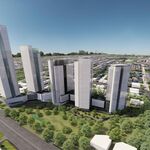kEiThZ
Superstar
If the land is valued at 2.5 billion, I would expect a reasonable - non-subsidized rent to work out to be around 120 million a year.
http://www.tc.gc.ca/air/airport-rent/fact/toronto.htm
Incidentally, that's less than Pearson pays right now.
It's a lot more than just emissions reductions. It's a major improvement in mobility for tens of millions of people. Spinoffs would be economic and in settlement patterns and even local transit use. Not to mention pollution around airports, where jet emissions are most concentrated. Incidentally I've heard estimates that emissions reductions would be a lot higher than 1%, but I don't have a source.
I was referring to the fact that aviation contributes 1-2% of total carbon emissions while cars and trucks contribute far, far more (in the order of 20-30%). My point was...does it make sense to spend 23 billion dollars to target the sector that generates 1% of carbon emissions when that money can be spent so much better elsewhere (ie local transit) to reduce emissions.
Why would intermediate stops be left out? Trains could stop at Cobourg or Belleville just as they do now. Express trains would obviously bypass those stations.
This again goes to the points I have made before. HSR everywhere else does not have anywhere close to the stop spacing that VIA currently does. Therefore HSR will not be serving several stops along the way...ie Port Hope, Trenton Jct, Napanee, Gananoque, etc. And if it does serve those routes with non-express trains, then those trains would likely be running a loss for VIA. In my experience as a regular VIA user, at least a good third to a half of passengers get on at a major city (Toronto, Ottawa, Montreal) and exit at the smaller stops along the way. I would not want to see service cut to these centres....and incidentally I could see that becoming a political issue if and HSR becomes a realistic proposal.
Where do you get the idea that this is a rush to imitate all things European? HSR has been studied extensively in the Canadian context for over 30 years. The agencies doing the studies (including governments) have expressed a high degree of confidence in their conclusions. A review of previous studies can be found here.
Studied extensively and not implemented for a number of reasons, namely our government does not wish to be involved in a project that would require immense capital outlays to sink a profitable business. It is instructive that out of all the studies posted on your link only one (the Lynx High speed rail system) said that it would be able to earn enough to return the original investment made by taxpayers....in 60 years. The rest all project an operating profit. That's like expecting Westjet to make a profit without having to pay the lease tab on its aircraft.
European systems do have stops outside downtown areas, as do proposed systems in North America.
I didn't mean stop spacing of nearly 30km like on the Eurostar. I meant something closer to what we have now, stations at Guildwood, Oshawa, etc. These stations make HSR more competitive with cars compared to planes by making rail more accessible outside of downtown.
Source?
Just a hunch. Given that Pearson alone makes $130 million, I am skeptical that any HSR could generate more revenue than the airports of Pearson, Trudeau, and macdonald-cartier including the rents they pay, the property taxes paid to local authorities and other taxes and fees that are generated. Many studies will show that HSR can generate an operating profit, but none have said that there's potential for governments to collect over $200 million in taxes and fees.
I've heard this before, and that VIA as a whole has a cost recovery of about 80%. I'd love to see a source for that info if you've got it though. If existing VIA operations in the Corridor make a profit, it would be pretty much impossible for HSR not to.
I'd agree that this is possible and more than likely that VIA makes a profit on the VDQ-Windsor corridor. The debate should be whether it's appropriate to spend 23 billion of the taxpayers dollars to merely improve the return slightly while simultaneously doing serious damage to the airlines operating in the corridor.
Anyway, it's tough to debate this now until we have the actually study on hand....if it turns out a lot less than 23 billion and service to smaller communities can be maintained I'd support it politically and with my travel dollars.




